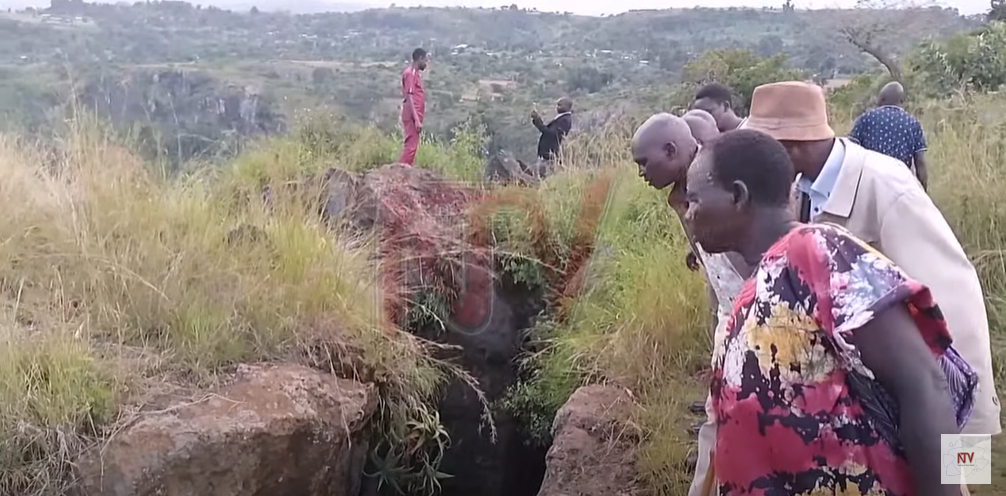Kapchorwa rock crack shakes over seven villages to the core

Residents and leaders stand on either side of Kicitya rock, which has developed cracks over the years, in Kapchorwa District.
What you need to know:
- Residents and leaders want the government to intervene and among others, resettle households in the area and also blast the rock.
Residents are on the edge after Kicitya rock in Kapchorwa District, Sebei Sub-region, developed cracks, with a possibility of displacing dozens of households.
When a Daily Monitor reporter visited the rock at the weekend in Kicitya Village, he found it has developed two huge cracks, about six metres wide, running through it from the top to bottom.
The cracks have split the rock, which sits on about half an acre of land into two large pieces, one on the left and the other on right.
At its foothill sits several villages, including Kicitya, Kaibet, Piyoswo, Kamutilai, Swesat, Cheptiwal and Ngunch. More than 300 households are at high risk.
The institutions at risk include Tumboboi Health Centre III, Tumboboi Primary School, Siron Primary School, Siron Technical School, Kaptany Seed Secondary School and Tumboboi Church.
Mr Stephen Chelimo, the chairperson of Siron Ward in Kapchorwa Municipality, said the cracks were narrow but for the past four years, they have been enlarging, causing a lot of fear about its collapse.
“We have alerted our leadership about the looming disaster but you know our leaders prefer responding after the disaster has occurred,” he said.
Mr Francis Tweluk, the chairperson of Kicitya Village, which got its name from the rock, said they have requested the government to blast the rock but in vain.
“We have reported but there has been no action taken. We have lost animals and children have also sustained injuries while trying to jump over the cracks to their schools," he said.
Two years ago, a sediment separated from the rock rolled down and rested about 100 metres from its original position after a heavy downpour. It nearly destroyed homes.
Ms Joyina Yeko, a councillor representing elders in Kaptanya Sub-county, said: “I grew up from here. I used to bring children here and they used to play on this rock and we could walk safely but now that is not possible because of cracks. This rock is going to kill us, if nothing is done,” Ms Yeko said.
Mr Francis Chemonges, the LCI chairperson of Sitya Village, said the government should send geologists to find out the problem before the situation gets worse.
“We have been living here for centuries and we have never had sleepless nights like we have today, especially when it rains heavily," he said.
The Chairperson of Kapyanya Sub-county, Mr Deni Soyekwo, said If Residents and leaders want the government to intervene and among
others, resettle households in the area and also blast the rock.
300 affected households
this rock is to roll down it would affect over 300 households in his sub-county including institutions like school, churches, crops and many others.
“We have made a report and we have held a meeting over the same. There has been commitment but no action. Our people need to be rescued as rain continues,” Mr Soyekwo said.
The Kapchorwa District chairperson, Ms Evelyn Kubarika, said the government should expedite the relocation of locals living near cracked rock.
“The danger is real and imminent and if the rock falls, the consequences would be catastrophic, resulting in significant loss and devastation,” Ms Kubarika said last Friday.
Mr Stephen Chelimo, 64, says the rock has been there since they were born but it started developing a crack in 1900s.
“The crack was narrow actually it was about 20 centimeters, we used to cross but as time went by it started enlarging until now that we can no longer jump over,” he said, adding that another crack has also emerged.
Mr Robert Chemusto, a resident of Swesat village, one of the villages neighbouring the cracked rock, said the government should expedite their relocation or blast the rock.
“We are living in fear because the crack has kept on enlarging and anytime the rock may disintegrate further and it collapses on us," he said.
Ms Joan Chebet, another resident, said they sometimes think their leaders do not care about them because for a long time, they have cried out for help [in vain].
“We have attended several meetings and informed our leaders but we have not received any positive response. They want to hear we are dead,” Ms Chebet said.
Mr Rogers Tweituk, a resident of Siron ward, another affected village, said whenever it rains they have sleepless nights. “We are no longer at peace because of the looming disaster that is hovering."
Government plans
Mr Dunstan Balaba, the Permanent Secretary at the Office of the Prime Minister, while addressing resettled landslide victims at Bunambutye resettlement site in Bulambuli last week said the government is committed to resettling all people at high risk in Mount Elgon.
“The Cabinet directed that each household that is going to be relocated be given Shs10 million on top of the Shs7 million that was given by Direct International, meaning that each household will get Shs17 million,” Mr Balaba said.
The government is supposed to move about 4,113 households in districts in Elgon Sub-region under a cash transfer strategy, with Bududa taking a big share of 1,993, Manafwa (894), Namisindwa (418), Sironko (455), Mbale (107), Kapchorwa (133), Bukwo (173), Bulambuli (210) and 254 in Kween.
The relocated households are expected to be given two acres of land to construct their houses and be taken care of by the government for a grace period of about three months.
Previously, the government used to construct a house sitting on one acre for the victims and also provided them with two acres for farming. The government has been resettling households at high risk of landslides in the Elgon Sub-region since the 2010 Nametsi landslide disaster where over 100 people were killed.
The survivors of the 2010 landslide were relocated to Kiryandongo District. However, in 2019, the government procured land for resettlement in Bulambuli.
Close to 300 families, comprising more than 5,000 people have so far been resettled over our heads,” Mr Tweituk said.
Mr Backson Kusuyo, a resident of Siron Ward in Kapchorwa Municipality, said if the rock collapses, it will also destroy their livelihood. “Our crops and animals will be killed as well. It will be a disaster that this country has never seen before,” he said.
Mr Tom Wandera, the Butaleja District environment officer, said changes in temperature or exposure of the rock to the effects of wind and rain causes it to crack.
“Water can get into cracks in a rock and, if it freezes, the ice will expand and push the cracks apart. As time goes it will widen and it will collapse at one time,” he said.




